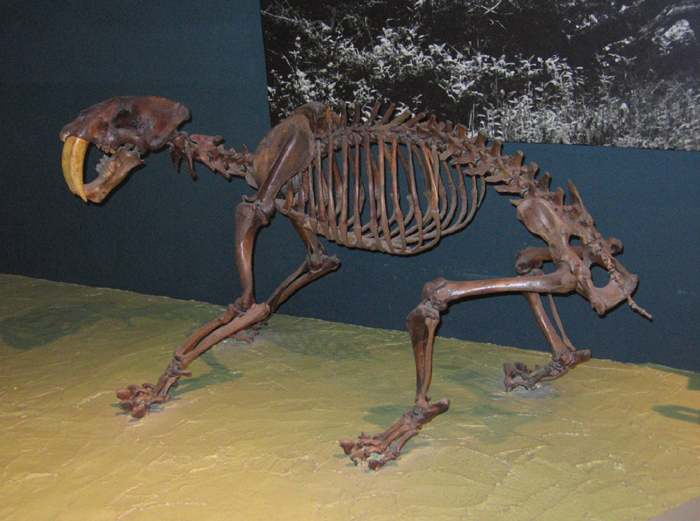Smilodon (Subfamily Machairodontinae) - Wiki Smilodon
From Wikipedia, the free encyclopedia
[Photo] Smilodon californicus fossil at the National Museum of Natural History, Washington, DC; digital photo by User:Postdlf http://en.wikipedia.org/wiki/User:Postdlf , 2/20/05
Smilodon (IPA: /smail????d??n/, a bahuvrihi from Greek: σμ??λη "knife" and (Ionic) ???δ??ν "tooth") is an extinct genus of large machairodontine sabre-toothed cats that are understood to have lived between approximately 3 million to 10,000 years ago in North and South America. They are probably the successors to Megantereon. The smilodon species are also known as Saber-toothed cat or Saber-Toothed Tigers.
The Smilodon is the prehistoric cat that is best known to researchers. They are very commonly incorrectly called "sabre toothed tigers." In truth, all modern day cats came from a completely different line.
Anatomy
A fully-grown Smilodon weighed approximately 200 kilograms (450 pounds) and had a short tail, powerful legs, and a large head. About the size of a lion, Smilodon was extremely powerful. Its jaws could open 120 degrees. Its fangs were about 17 cm (7 inches) long. Smilodon also had a bobtail. It might have been able to run up to 30mph in short bursts. It's not known if its coat was striped, spotted or tawny.
Lifestyle and Behavior
The social pattern of this cat is unknown. Some fossils show healed injuries or diseases that would have crippled the animal. Some paleontologists see this as evidence that saber-toothed cats were social animals, living and hunting in packs that provided food for old and sick members. Living in groups would also help with having to compete with lions and wolves. Smilodon lived in grasslands, or pine forests with rocky soil. A majority of fossils have been discovered in areas such as these.
In addition to killing prey, the long canines of Smilodon might have also had the same use as a lion's mane. The cats with the largest fangs may have attracted the most mates.
The canine teeth of Smilodon are are about the same size in male and female cats. This indicates that Smilodon may not have lived in groups. However, it still could have hunted cooperatively.
Diet and hunting
Smilodon probably preyed on a wide variety of game including; bison, elk, deer, american camels, ground sloths (megatherium and other related species), horses and the young prehistoric elephants like the mammoth (giant imperial mammoth (Mammuthus imperator), jeffersonian mammoth (Mammuthus jeffersonii), columbian mammoth (Mammuthus columbi), woolly mammoth, and the mastadon).
Recent investigations suggest that this saber-toothed cat probably used its long canines to slash through the throat, severing the wind pipe and cutting the jugular. Its teeth were surprisingly delicate and could easily snap off if a prey animal struggled. Its mouth could open up to 120 degrees, whereas the modern lion, Panthera leo, can only open its jaws to 65 degrees.
Smilodon was quite robust for a feline. Stress patterns on Smilodon bones indicate that it used its powerfully built forelegs to subdue its prey, making it easier to use its teeth.
Classifiction and species
The genus Smilodon was described by the Danish naturalist and palaeontologist Peter Wilhelm Lund in 1841. He found the fossils of Smilodon populator in caves near the small town of Lagoa Santa, in the state of Minas Gerais, Brazil.
As many as six species of Smilodon are known to have existed:
- Smilodon fatalis, 1.6 million-10,000 years ago
- Smilodon gracilis, 2.5 million-500,000 years ago
- Smilodon populator, 1 million-10,000 years ago
- Smilodon neogaeus, 3 million-500,000 years ago
- Smilodon floridus, may be a subspecies of Smilodon fatalis
- Smilodon californicus, may be a subspecies of Smilodon fatalis.
La Brea tar pits
The La Brea tar pits in Los Angeles trapped hundreds of Smilodon in the tar, possibly as they tried to feed on mammoths already trapped. There is a museum there today which has many of their complete skeletons.
http://en.wikipedia.org/wiki/Smilodon
| The text in this page is based on the copyrighted Wikipedia article shown in above URL. It is used under the GNU Free Documentation License. You may redistribute it, verbatim or modified, providing that you comply with the terms of the GFDL. |
